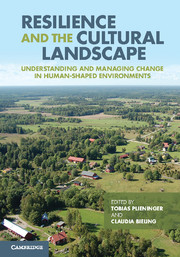 Resilience and the Cultural Landscape
Resilience and the Cultural Landscape Book contents
- Frontmatter
- Contents
- List of contributors
- Preface
- Part I Conceptualising landscapes as social–ecological systems
- Part II Analysing landscape resilience
- 7 In search of resilient behaviour: using the driving forces framework to study cultural landscapes
- 8 Cultural landscapes as complex adaptive systems: the cases of northern Spain and northern Argentina
- 9 Linking path dependency and resilience for the analysis of landscape development
- 10 The sugar-cane landscape of the Caribbean islands: resilience, adaptation and transformation of the plantation social–ecological system
- 11 Offshore wind farming on Germany’s North Sea coast: tracing regime shifts across scales
- Part III Managing landscapes for resilience
- Part IV Perspectives for resilient landscapes
- Index
- References
10 - The sugar-cane landscape of the Caribbean islands: resilience, adaptation and transformation of the plantation social–ecological system
Published online by Cambridge University Press: 05 November 2012
- Frontmatter
- Contents
- List of contributors
- Preface
- Part I Conceptualising landscapes as social–ecological systems
- Part II Analysing landscape resilience
- 7 In search of resilient behaviour: using the driving forces framework to study cultural landscapes
- 8 Cultural landscapes as complex adaptive systems: the cases of northern Spain and northern Argentina
- 9 Linking path dependency and resilience for the analysis of landscape development
- 10 The sugar-cane landscape of the Caribbean islands: resilience, adaptation and transformation of the plantation social–ecological system
- 11 Offshore wind farming on Germany’s North Sea coast: tracing regime shifts across scales
- Part III Managing landscapes for resilience
- Part IV Perspectives for resilient landscapes
- Index
- References
Summary
Introduction
The plantation sugar-cane landscape has been the most distinctive cultural landscape in a number of Caribbean islands since colonisation, surviving in its basic form for over 500 years. We regard it as the physical manifestation of a well-defined social–ecological system that has demonstrated remarkable resilience – defined as ‘the capacity of a system to experience shocks while retaining essentially the same function, structure, feedback and, therefore, identity’ (Walker et al., 2006). While the landscape has survived in its general form for centuries, the plantation system it reflects has undergone dynamic changes in space and time that have facilitated resilience, changes that have included a transition from the system’s most notorious feature – slavery – to the current period of rationalisation and decline. This chapter illustrates how one can understand the sugar-cane landscape through the lens of resilience thinking – and through reference to the heuristics of adaptive cycles and panarchy, in particular. It also offers interpretations of different forms of sugar-cane landscape as cultural landscapes, and illustrates how this perspective can be combined with resilience thinking to enrich our understanding of landscape character and change.
Caribbean sugar-cane cultural landscape
Sugar-cane has been grown commercially in the Caribbean islands (Figure 10.1) since the early sixteenth century. The plantation is both an agricultural and an industrial site, and buildings important to production (e.g. mills, housing for workers) and populations supplying the labour form important components of the cultural landscape. At one time, most inhabited islands of the Caribbean produced cane, but the dates when cultivation was first introduced and then terminated, the technologies used in the agricultural/industrial process, the inclusion of non-sugar land uses in the landscape and the populations forming the labour supply have varied significantly from island to island. Even within individual islands, sugar-cane landscapes have reflected local variation. Large plantations, owned by individuals, companies or governments, have dominated the areas of sugar production, tending to occupy the land with the highest quality, but small properties, sometimes using traditional techniques on marginal lands, have coexisted. Thus, while the distinctive light-green sugar-cane component of the landscape has persisted for centuries, its dominant visual impact has tended to obscure important space/time variations.
- Type
- Chapter
- Information
- Resilience and the Cultural LandscapeUnderstanding and Managing Change in Human-Shaped Environments, pp. 164 - 184Publisher: Cambridge University PressPrint publication year: 2012
References
- 2
- Cited by


